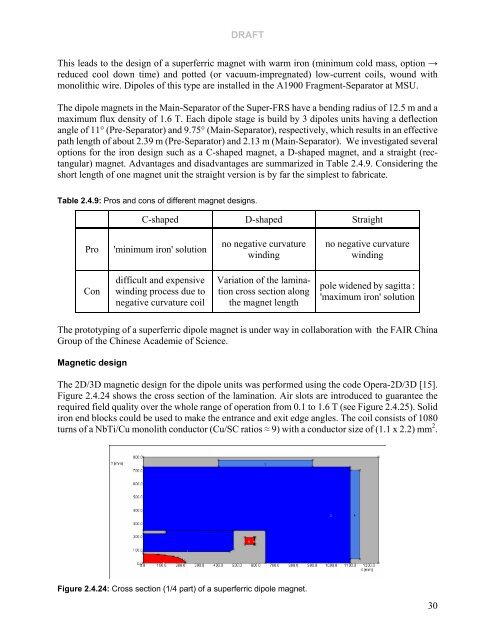Technical Design Report Super Fragment Separator
Technical Design Report Super Fragment Separator
Technical Design Report Super Fragment Separator
Create successful ePaper yourself
Turn your PDF publications into a flip-book with our unique Google optimized e-Paper software.
DRAFT<br />
This leads to the design of a superferric magnet with warm iron (minimum cold mass, option →<br />
reduced cool down time) and potted (or vacuum-impregnated) low-current coils, wound with<br />
monolithic wire. Dipoles of this type are installed in the A1900 <strong>Fragment</strong>-<strong>Separator</strong> at MSU.<br />
The dipole magnets in the Main-<strong>Separator</strong> of the <strong>Super</strong>-FRS have a bending radius of 12.5 m and a<br />
maximum flux density of 1.6 T. Each dipole stage is build by 3 dipoles units having a deflection<br />
angle of 11° (Pre-<strong>Separator</strong>) and 9.75° (Main-<strong>Separator</strong>), respectively, which results in an effective<br />
path length of about 2.39 m (Pre-<strong>Separator</strong>) and 2.13 m (Main-<strong>Separator</strong>). We investigated several<br />
options for the iron design such as a C-shaped magnet, a D-shaped magnet, and a straight (rectangular)<br />
magnet. Advantages and disadvantages are summarized in Table 2.4.9. Considering the<br />
short length of one magnet unit the straight version is by far the simplest to fabricate.<br />
Table 2.4.9: Pros and cons of different magnet designs.<br />
C-shaped D-shaped Straight<br />
Pro 'minimum iron' solution<br />
Con<br />
difficult and expensive<br />
winding process due to<br />
negative curvature coil<br />
no negative curvature<br />
winding<br />
Variation of the lamination<br />
cross section along<br />
the magnet length<br />
no negative curvature<br />
winding<br />
pole widened by sagitta :<br />
'maximum iron' solution<br />
The prototyping of a superferric dipole magnet is under way in collaboration with the FAIR China<br />
Group of the Chinese Academie of Science.<br />
Magnetic design<br />
The 2D/3D magnetic design for the dipole units was performed using the code Opera-2D/3D [15].<br />
Figure 2.4.24 shows the cross section of the lamination. Air slots are introduced to guarantee the<br />
required field quality over the whole range of operation from 0.1 to 1.6 T (see Figure 2.4.25). Solid<br />
iron end blocks could be used to make the entrance and exit edge angles. The coil consists of 1080<br />
turns of a NbTi/Cu monolith conductor (Cu/SC ratios ≈ 9) with a conductor size of (1.1 x 2.2) mm 2 .<br />
Figure 2.4.24: Cross section (1/4 part) of a superferric dipole magnet.<br />
30















